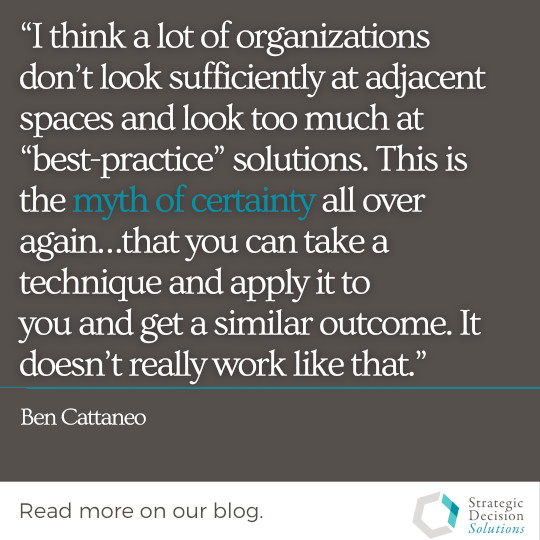Woven into many of my posts from the last 4+ years is the advice that ERM best practices should be approached with caution. While the updated COSO and ISO 31000 standards can be great starting points for some organizations, simply copying another organization’s policies and practices comes with many drawbacks that will eventually become painful.
At best, taking this approach yields a process that is bureaucratic and cumbersome, and at worst, can exacerbate current challenges or create new ones. If this occurs, the reputation that ERM is just another “check-the-box” activity will be burnished in the minds of executives and managers even more.
So this naturally leads us to ask – why is following ERM best practices wrought with so many pitfalls?
After all, we use guidelines and best practices in other areas of the company or in our personal lives all the time.
When it comes to ERM best practices, copying what others do rarely works out because every organization is unique.
Every company is going to have its own unique culture, customers, financial conditions, leadership, vision, and risk appetite that will necessitate customized processes for identifying, assessing, and factoring risks into decision-making.
This even applies to companies in the same industry. Take an industry I’m well familiar with, Florida’s property & casualty insurance market, as one example. As I explained in this guest article for The Demotech Difference, companies in the startup phase will have completely different needs than ones who are well-established, and every company is different, whether due to its target market, its systems, its distribution channel, etc.
Now I don’t want to imply that you shouldn’t try to understand what others are doing.
With this in mind, a session on uncertainty from the recent Risk Awareness Week 2020 by Ben Cattaneo, long-time risk professional and host of the AllThingsRisk podcast, caught my attention.
While uncertainty has always been around, it seems to have taken on a new twist with this year’s COVID-19 pandemic. Even without this ongoing health emergency, the world was already changing at lightning speed. This trend is not only expected to continue but accelerate in the years ahead.
Whether it’s risk or some operational process, focusing on “best-practices” without considering your company’s specific needs, goals, or challenges is an approach that clings to certainty. Catteneo explains:

Instead of looking within, it may be more useful for risk professionals to look at what individuals, groups, or companies outside their space are doing.
Cattaneo specifically draws attention to the characteristics of adrenaline junkies who, as opposed to the stereotype of being reckless, are in fact very analytical, curious and well-aware of the risks they are taking. He explains how these individuals who are always testing limits understand how to embrace uncertainty.
Additionally, adrenaline junkies are typically doing things that haven’t really been done before, so they by necessity have to look in what may seem to be unrelated spaces to understand the best way forward. Adrenaline junkies have to innovate carefully because they are well aware that not all risks can be mitigated away.
One example is the rescue of the Wild Boars football (soccer) team in Thailand in 2018. Shortly after finishing practice on June 23rd, twelve teenage members of the team and an assistant coach went exploring the Tham Luang cave and became trapped when monsoon rains flooded their pathway out.
Cattaneo interviewed Dr. Richard Harris on his podcast on how he used his experience as both a cave diver and anesthesiologist to help eventually get the boys to safety. Dr. Harris illustrates the point about how best practices can do more harm than good when he explains:
The other guys on the [rescue] team who were not medical could not comprehend or see all of the problems I could see. To them it was not so clear that it was an impossible thing to do, but armed with the knowledge I had, I couldn’t see how it could work.
In short, Dr. Harris administered an anesthetic that knocked each of the boys out, thus, preventing them from panicking as the rescuers navigated them through tightly submerged spaces. If rescue teams had gone with a standard “best-practice” approach, this story would likely not have seen a happy ending.
Fortunately, we do not encounter such high-stakes, life-and-death situations in our organizations. At work, we are afforded the opportunity to take a step back and recalibrate our approach – should we reiterate or pivot?
But as Dr. Harris’ and other stories illustrate, blindly using “best-practices” can in fact do more harm than good in the long run.
As a risk professional, have you ever looked beyond ERM practices to figure out other possible ways to identify, assess, and factor risk into your organization’s decisions?
I’m always interested in learning how other risk practitioners are helping their organizations. Share your thoughts by leaving a comment below or join the conversation on LinkedIn.
If you visit my consulting firm’s website, you will see that we specialize in developing unique ERM and strategy solutions to help insurance companies overcome challenges. If your company, be it insurance or in any industry, is desperate for a workable solution to vexing risk management challenges, reach out to me to discuss your specific situation today.
Featured image courtesy of Suliman Sallehi via Pexels.com








